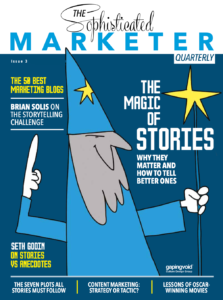
Guest post by Todd Blecher, Communications Director, The Boeing Company
Much wisdom did Yoda accumulate. But experience with social media I think not the Jedi had. Yoda’s insistence that we “do, or do not. There is no try,” to brand journalism does not apply.
When it comes to brand journalism the instruction should be “Try. There is no do or do not.” In fact, since April, 2010, when we transformed www.boeing.com into a brand journalism platform, we’ve been all about trying. We started with modest goals and walk-then-run approach that has been essential to sustainable success.
Starting with walking seems obvious but not everybody does it. It not only builds your experience in a manageable way it also helps gain essential internal cooperation. We designed our initial stages as a trial run that could be halted relatively easily. Going slow helped address the unease of doing something new (aka risky) that we found in some corners. It got our nose under the tent and allowed for gradually picking up the pace when the time was right.
From what we’ve learned success with brand journalism seems to flow with the force of some basic principles outlined below.
First and foremost, as with any communications effort, brand journalism must be part of an overall communications strategy. If it’s not, its content will communicate in a vacuum, with little benefit to the organization and of little interest to audiences.
When thinking about brand journalism content an organization must recognize that the stories must, as Shel Holtz recently put it, “be inspiring, clarifying, funny, useful or just plain interesting.” Developing such content requires thinking like an audience member and not just a representative of the organization. Content that serves a communications strategy must be shared. Content that meets what Holtz outlined has a much higher likelihood of being shared than content that doesn’t.
Many organizations, however, won’t allow for thinking like an audience member. They should not do brand journalism.
For those ready to try brand journalism I would recommend hiring some former journalists. And I say to former journalists, as David Meerman Scott put it in this column, consider the opportunities of working for brands. Being that kind of journalist isn’t akin to joining the Dark Side, as some would have you believe.
Having former media journalists doing your brand journalism should save time, money, and aggravation because they are trained to create the engaging content that brand journalism requires. What’s more, they know the necessary tricks of the trade. Organizations doing brand journalism are publishers. They need to think about broad and timely content distribution, editorial calendars, and a strategy for repurposing stories. Former media journalists know how to do all that.
As you may’ve guessed, we have many former reporters on our team. While it’s possible to hire such talent on a project-by-project basis, the best brand journalism requires commitment, access, and trust. Those all seem to come easier for an in-house journalist.
When brand journalists think of what’s interesting to their audiences and create engaging content they generate stories that can, pardon the pun, really take off. Here’s one of ours that did. This story is about testing the brakes on our new 747. The test involves speeding an airplane down a runway then hitting the brakes just before takeoff. It ends with the brakes on fire, which is eye catching, to say the least.
That story had it all for our audiences: iconic airplane, an interesting test activity, and great visuals. We’ve had more than 1.1 million views, and our key messages about safety and durability reached more people through our website, YouTube channel, and Facebook page, than we would’ve reached with a traditional news release.
Another, albeit more unexpected success, came with this story about our Phantom Eye unmanned system. It has more than 400,000 views, a lot for a military story as those usually appeal to a niche audience. This one broke out by presenting a new and unique vehicle in a way that sparked imaginations and discussions.
We’ve certainly had our share of stories that didn’t work. Here are two: this one is about a retiring security dog while this story is about designs for World War Two-era uniforms. Our audiences didn’t know what to make of either of them.
Overall, however, we think (metrics remain a work in progress) that we’re succeeding more often than not. We’ve concluded that brand journalism is a very useful communications tool that, if an organization is prepared to properly pursue it, is worth trying. And doing.
This is part of a series on brand journalism / brand publishing as told by the businesses that are paving the way. Please send me a note if you would like to tell your company’s story on its move to what Tom Foremski dubbed EC=MC, Every Company is a Media Company.
Image Credit: Shutterstock





thanks Todd for sharing. a cool story.
i’m wondering: how do you organize your “journalism” operation? do you use any software tools to manage your editorial calendar, your content production, your promotion efforts to earn links & your metrics?
Here are simple tests to check if your audience will easily understand what you’ve…
Hi Brian! I’m constantly following your blog and I’m very thankful for your insights. However, I got surprised by this article and decided to contribute with an opposite view. I hope to spark a healthy discussion here on your blog!
While reading your article I could not avoid thinking that “Brand Journalism” sounds like a terrible concept! Don’t get me wrong, I’m a Brand Identity Design specialist. I spend my days solving branding problems and educating my clients in terms of Branding. More than the average Joe, I know very well how powerful brand activities can be.
But on the other hand, I’m also a communicator and I do appreciate the unbiased value that is traditionally attached to the concept of Journalism. On a personal level, even thought I’m not a journalist myself, I wouldn’t like to see “Journalism” tainted as just another commercially bias form of communication.
You said that: “—Being that kind of journalist isn’t akin to joining the Dark Side, as some would have you believe.”
Well, I disagree. Isn’t a Journalist most fundamental value to serve the society? How can “Brand Journalism” ever achieve that if the goal is to represent the brand values? According to Wikipedia:
“Journalism is the practice of investigation and reporting of events, issues and trends to a broad audience in a timely fashion. Though there are many variations of journalism, the ideal is to inform the intended audience.”
In the same page of Wikipedia, you’ll find the nine elements of Journalism which I believe are taken fairly seriously by journalists from all around the world. This is the list:
1. Journalism’s first obligation is to the truth.
2. Its first loyalty is to the citizens.
3. Its essence is discipline of verification.
4. Its practitioners must maintain as independence from those they cover.
5. It must serve as an independent monitor of power.
6. It must provide a forum for public criticism and compromise.
7. It must strive to make the news significant, interesting, and relevant.
8. It must keep the news comprehensive and proportional.
9. Its practitioners must be allowed to exercise their personal conscience.
How can “Brand Journalism” ever uphold these values while also being a marketing activity?
Leaving the “Brand” out of “Journalism” and vice-versa seems to me as a very natural thing to do. They are entirely opposite concepts and from my point-of-view creating a new concept called “Brand Journalism” is just helping to discredit the value of Journalism itself. After-all, we know is going to be all about branding positioning.
I really hope you don’t get me wrong here. I’m a big fan of your book, I think you’re a great fellow and I’ll continue to follow and appreciate all you have to offer on your blog. I just need to put my two cents out there. Thanks! 🙂
Hello Ray. This is a movement and one of the working names is Brand Journalism. Another is EC=MC (Every Company is a Media Company) – Tom Foremski. Others refer to it as simply Publishing. However, your questions about the post itself will have to be answered by its author Todd Blecher.
I missed Todd’s name at the beginning of the post! Oops! Thanks for passing by and clarifying that point! 🙂
I’m aware of this movement and considering the easy access of starting your own media outlet it seems like a natural thing for companies to be investing their time and effort — but calling it some sort of “Journalism” seems to be a little bit too much. I think “Brand Publishing” seems to be a fairer way of putting it.
This reminds me Brian of something I once heard, “I try, and try and try. I
triple my trying and double my success.” In my opinion, these great insights
work very well for small businesses or the little guy as well.
One of the greatest needs that people have is to be inspired and to inspire.
Being inspired and optimistic is one thing; trying to inspire is another. Old
school story tellers, cling to the theories and models that have worked in the
past, continuing to look for answers “out there.” The next generation story
tellers in business today, search for wisdom “in here.” The former is based on
telling you how it is; the latter is inspired by think for yourself with
engaging connection and brings out the best in others content.
I believe this is a great post. A company can come up with an idea, a product and a campaign, but if it doesn’t have the right people working in the right places, the story and the underlying message are lost in the sea of billions failed ad campaigns. It takes an outstanding story to be memorable to the audience. With media journalists who have the experience in communications behind brand journalism, a company can successfully achieve its goals. The difficult part is not creating the story, it’s knowing how to catch the audience’s eye.
this is real force behind the business